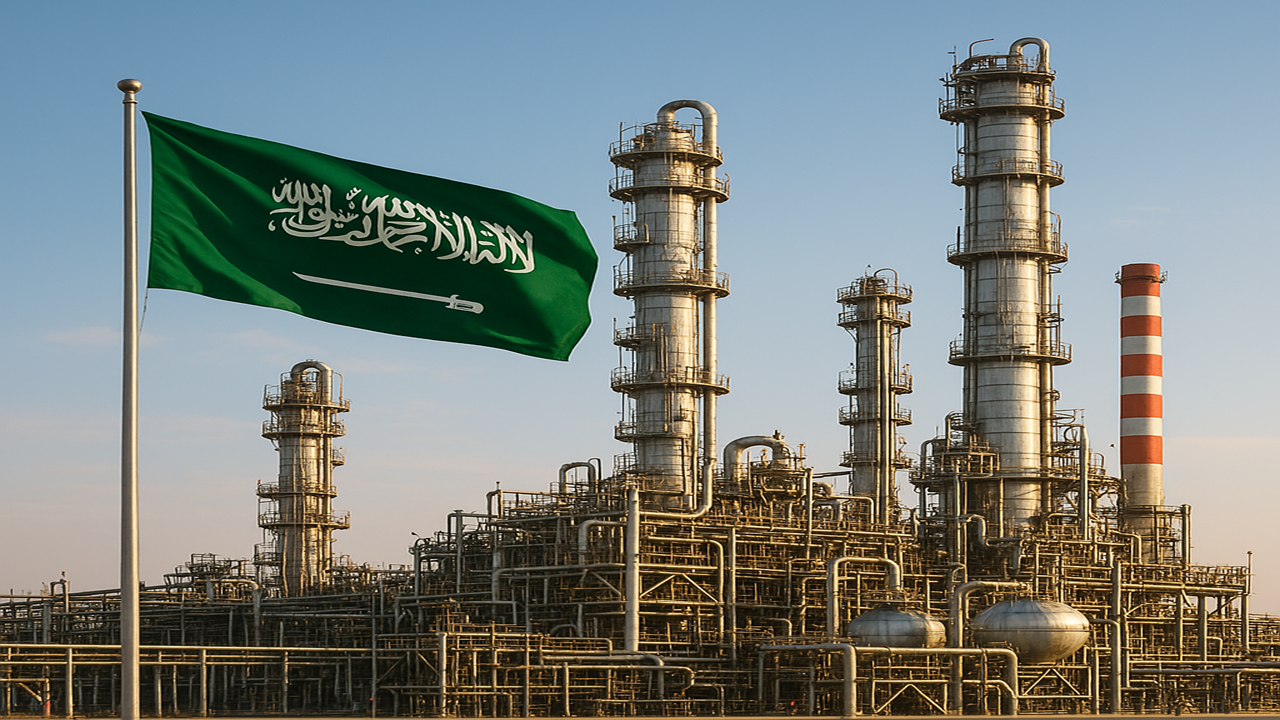In a move that reverberated across global markets, Saudi Arabia has sharply lowered its oil prices for Asian buyers, bringing them close to pandemic-era lows. The decision, announced Sunday by state oil giant Aramco, signals a potential pivot in strategy from the Kingdom just days after OPEC+ unexpectedly accelerated its oil output increases. The May official selling price (OSP) for Arab Light crude — Saudi Arabia’s flagship grade — was cut by $2.
30 to $1.20 per barrel above the average of Oman and Dubai benchmarks. It's the steepest price drop in more than two years and lands prices at levels not seen since early 2021, when the world was still in the grip of the COVID-19 pandemic.

For Asia, the signal is clear: Riyadh is willing to forgo short-term price stability in a bid to retain market share as competition stiffens. A Coordinated Supply Shift — Or a Flashback to Market Wars? The timing of Aramco’s announcement was no coincidence. Just days prior, OPEC+—the alliance of oil-producing nations led by Saudi Arabia and Russia—surprised the market by bringing forward its production ramp-up plan.
The group agreed to boost supply by 411,000 barrels per day starting in May, more than triple the originally expected increase. That jump represents roughly 0.4% of global oil supply—a small fraction numerically, but a meaningful shift in a tightly balanced market.
Analysts are already drawing parallels to past market-share battles, particularly those seen in 2015 and 2016 when Saudi Arabia spearheaded a price war to crowd out U.S. shale producers.
“This could raise fears of the Kingdom reverting to the market share strategy of 2015 and 2016 when OPEC was unable to respond effectively to rising U.S. supply,” said Callum Macpherson, head of commodities at Investec.
“However, it does not look that serious yet. This could also be in response to producers like Iraq and Kazakhstan, who consistently produce above their quota.” Pressure from Within and Without The internal dynamics of OPEC+ are also shaping the situation.
While Saudi Arabia has long been the bloc’s enforcer of production discipline — its budget depends on oil prices around $90 a barrel — others have quietly drifted above their quotas. Adding fuel to the fire, global oil prices plunged nearly 11% in the week ending April 4, hitting their lowest levels in over three years. That drop came amid not only the OPEC+ output news, but also escalating tensions from a global trade war that’s rippling through energy demand forecasts.
The broader decline in benchmark prices also pressured Saudi Arabia to adjust. Dubai crude’s spot premium fell to $1.38 per barrel in March — down from $3.
33 in February — due in part to Russian oil returning to Asian markets after earlier disruptions from U.S. sanctions.
Across-the-Board Price Cuts Aramco’s move wasn’t limited to Arab Light. Every grade headed for Asia saw a $2.30-per-barrel cut, from Super Light down to Heavy crude.
In Europe and the U.S., price adjustments were more modest — typically around $0.
20 to $0.50 per barrel — suggesting that the Kingdom is prioritizing competitiveness in Asia, its biggest and most contested export market. Here's how the May price changes break down: Asia-bound Arab Light: cut to +$ 1.
20/barrel Asia-bound Arab Heavy: dropped into negative territory at -$0.50/barrel Northwest Europe and Mediterranean: reductions of $0.50/barrel U.
S. destinations: modest $0.20 cuts across grades These sharp discounts could sway buyers back toward Saudi barrels after months of competition from discounted Russian and West African crudes.
What's Next for Global Oil Markets? While some see this as a tactical reset, others worry it may mark the early innings of another oil price war — one that could destabilize already fragile energy markets. If demand doesn’t rebound swiftly and OPEC+ continues to unwind production cuts, more downward pressure on prices could follow. With geopolitical instability and trade uncertainty lingering, oil’s next chapter could be more volatile than ever.
Still, Saudi Arabia’s play may be less about flooding the market and more about sending a clear message: in a reshuffling global energy order, it’s not ready to cede ground..
Saudi Arabia Slashes Oil Prices to Asia Amid OPEC+ Output Surge

Saudi Arabia Slashes Oil Prices to Asia Amid OPEC+ Output Surge In a move that reverberated across global markets, Saudi Arabia has sharply lowered its oil prices for Asian buyers, bringing them close to pandemic-era lows. The decision, announced Sunday by state oil giant Aramco, signals a potential pivot in strategy from the Kingdom just days after OPEC+ unexpectedly accelerated its oil output increases.The May official selling price (OSP) for Arab Light crude — Saudi Arabia's flagship grade — was cut by $2.30 to $1.20 per barrel above the average of Oman and Dubai benchmarks. It's the steepest price drop in more than two years and lands prices at levels not seen since early 2021, when the world was still in the grip of the COVID-19 pandemic.For Asia, the signal is clear: Riyadh is willing to forgo short-term price stability in a bid to retain market share as competition stiffens.A Coordinated Supply Shift — Or a Flashback to Market Wars?The timing of Aramco's announcement was no coincidence. Just days prior, OPEC+—the alliance of oil-producing nations led by Saudi Arabia and Russia—surprised the market by bringing forward its production ramp-up plan. The group agreed to boost supply by 411,000 barrels per day starting in May, more than triple the originally expected increase.That jump represents roughly 0.4% of global oil supply—a small fraction numerically, but a meaningful shift in a tightly balanced market.Analysts are already drawing parallels to past market-share battles, particularly those seen in 2015 and 2016 when Saudi Arabia spearheaded a price war to crowd out U.S. shale producers."This could raise fears of the Kingdom reverting to the market share strategy of 2015 and 2016 when OPEC was unable to respond effectively to rising U.S. supply," said Callum Macpherson, head of commodities at Investec. "However, it does not look that serious yet. This could also be in response to producers like Iraq and Kazakhstan, who consistently produce above their quota."Pressure from Within and WithoutThe internal dynamics of OPEC+ are also shaping the situation. While Saudi Arabia has long been the bloc's enforcer of production discipline — its budget depends on oil prices around $90 a barrel — others have quietly drifted above their quotas.Adding fuel to the fire, global oil prices plunged nearly 11% in the week ending April 4, hitting their lowest levels in over three years. That drop came amid not only the OPEC+ output news, but also escalating tensions from a global trade war that's rippling through energy demand forecasts.The broader decline in benchmark prices also pressured Saudi Arabia to adjust. Dubai crude's spot premium fell to $1.38 per barrel in March — down from $3.33 in February — due in part to Russian oil returning to Asian markets after earlier disruptions from U.S. sanctions.Across-the-Board Price CutsAramco's move wasn't limited to Arab Light. Every grade headed for Asia saw a $2.30-per-barrel cut, from Super Light down to Heavy crude. In Europe and the U.S., price adjustments were more modest — typically around $0.20 to $0.50 per barrel — suggesting that the Kingdom is prioritizing competitiveness in Asia, its biggest and most contested export market.Here's how the May price changes break down:Asia-bound Arab Light: cut to +$ 1.20/barrelAsia-bound Arab Heavy: dropped into negative territory at -$0.50/barrelNorthwest Europe and Mediterranean: reductions of $0.50/barrelU.S. destinations: modest $0.20 cuts across gradesThese sharp discounts could sway buyers back toward Saudi barrels after months of competition from discounted Russian and West African crudes.What's Next for Global Oil Markets?While some see this as a tactical reset, others worry it may mark the early innings of another oil price war — one that could destabilize already fragile energy markets.If demand doesn't rebound swiftly and OPEC+ continues to unwind production cuts, more downward pressure on prices could follow. With geopolitical instability and trade uncertainty lingering, oil's next chapter could be more volatile than ever.Still, Saudi Arabia's play may be less about flooding the market and more about sending a clear message: in a reshuffling global energy order, it's not ready to cede ground.











